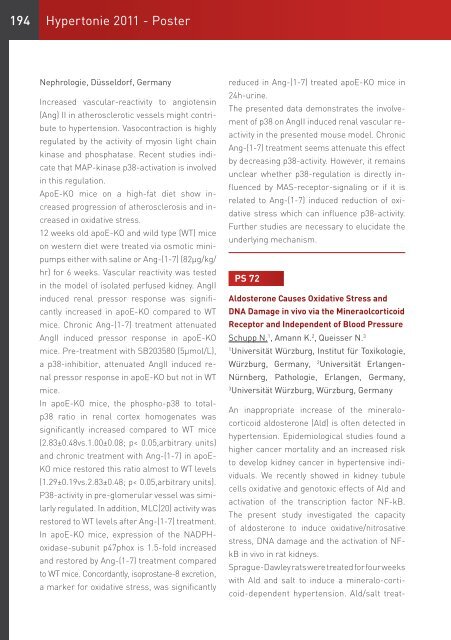Hier können Sie sich das Abstractbuch zum ... - Hypertonie 2011
Hier können Sie sich das Abstractbuch zum ... - Hypertonie 2011
Hier können Sie sich das Abstractbuch zum ... - Hypertonie 2011
Erfolgreiche ePaper selbst erstellen
Machen Sie aus Ihren PDF Publikationen ein blätterbares Flipbook mit unserer einzigartigen Google optimierten e-Paper Software.
194 <strong>Hypertonie</strong> <strong>2011</strong> - Poster <strong>Hypertonie</strong> <strong>2011</strong> - Poster 195<br />
Nephrologie, Düsseldorf, Germany<br />
Increased vascular-reactivity to angiotensin<br />
(Ang) II in atherosclerotic vessels might contribute<br />
to hypertension. Vasocontraction is highly<br />
regulated by the activity of myosin light chain<br />
kinase and phosphatase. Recent studies indicate<br />
that MAP-kinase p38-activation is involved<br />
in this regulation.<br />
ApoE-KO mice on a high-fat diet show increased<br />
progression of atherosclerosis and increased<br />
in oxidative stress.<br />
12 weeks old apoE-KO and wild type (WT) mice<br />
on western diet were treated via osmotic minipumps<br />
either with saline or Ang-(1-7) (82µg/kg/<br />
hr) for 6 weeks. Vascular reactivity was tested<br />
in the model of isolated perfused kidney. AngII<br />
induced renal pressor response was significantly<br />
increased in apoE-KO compared to WT<br />
mice. Chronic Ang-(1-7) treatment attenuated<br />
AngII induced pressor response in apoE-KO<br />
mice. Pre-treatment with SB203580 (5µmol/L),<br />
a p38-inhibitior, attenuated AngII induced renal<br />
pressor response in apoE-KO but not in WT<br />
mice.<br />
In apoE-KO mice, the phospho-p38 to totalp38<br />
ratio in renal cortex homogenates was<br />
significantly increased compared to WT mice<br />
(2.83±0.48vs.1.00±0.08; p< 0.05,arbitrary units)<br />
and chronic treatment with Ang-(1-7) in apoE-<br />
KO mice restored this ratio almost to WT levels<br />
(1.29±0.19vs.2.83±0.48; p< 0.05,arbitrary units).<br />
P38-activity in pre-glomerular vessel was similarly<br />
regulated. In addition, MLC(20) activity was<br />
restored to WT levels after Ang-(1-7) treatment.<br />
In apoE-KO mice, expression of the NADPHoxi<strong>das</strong>e-subunit<br />
p47phox is 1.5-fold increased<br />
and restored by Ang-(1-7) treatment compared<br />
to WT mice. Concordantly, isoprostane-8 excretion,<br />
a marker for oxidative stress, was significantly<br />
reduced in Ang-(1-7) treated apoE-KO mice in<br />
24h-urine.<br />
The presented data demonstrates the involvement<br />
of p38 on AngII induced renal vascular reactivity<br />
in the presented mouse model. Chronic<br />
Ang-(1-7) treatment seems attenuate this effect<br />
by decreasing p38-activity. However, it remains<br />
unclear whether p38-regulation is directly influenced<br />
by MAS-receptor-signaling or if it is<br />
related to Ang-(1-7) induced reduction of oxidative<br />
stress which can influence p38-activity.<br />
Further studies are necessary to elucidate the<br />
underlying mechanism.<br />
PS 72<br />
Aldosterone Causes Oxidative Stress and<br />
DNA Damage in vivo via the Mineraolcorticoid<br />
Receptor and Independent of Blood Pressure<br />
Schupp N. 1 , Amann K. 2 , Queisser N. 3<br />
1Universität Würzburg, Institut für Toxikologie,<br />
Würzburg, Germany, 2Universität Erlangen-<br />
Nürnberg, Pathologie, Erlangen, Germany,<br />
3Universität Würzburg, Würzburg, Germany<br />
An inappropriate increase of the mineralocorticoid<br />
aldosterone (Ald) is often detected in<br />
hypertension. Epidemiological studies found a<br />
higher cancer mortality and an increased risk<br />
to develop kidney cancer in hypertensive individuals.<br />
We recently showed in kidney tubule<br />
cells oxidative and genotoxic effects of Ald and<br />
activation of the transcription factor NF-kB.<br />
The present study investigated the capacity<br />
of aldosterone to induce oxidative/nitrosative<br />
stress, DNA damage and the activation of NFkB<br />
in vivo in rat kidneys.<br />
Sprague-Dawleyratsweretreatedforfourweeks<br />
with Ald and salt to induce a mineralo-corticoid-dependent<br />
hypertension. Ald/salt treat-<br />
ment increased the blood pressure, which was<br />
lowered by tempol, an antioxidant, and hydralazine,<br />
a vasodilator, but not by the mineralocorticoid<br />
receptor (MR) antagonist spironolactone,<br />
administered in a subtherapeutical dose.<br />
Ald/salt treatment caused oxidative stress,<br />
evaluated with dihydroethidium, structural DNA<br />
damage, determined in the comet assay, double<br />
strand breaks, nitric oxide/peroxynitrite production<br />
and NF-kB activation, detected immunhistochemically.<br />
Spironolactone and tempol<br />
decreased all these markers significantly,<br />
while hydralazine had no effect. Ald/salt-treated<br />
kidneys showed a tendency to less apoptosis<br />
and to increased cell proliferation.<br />
This study for the first time shows blood pressure-independent<br />
oxidative and genotoxic effects<br />
of Ald in vivo. Crucial for these effects of Ald is<br />
the MR and the production of ROS. Long-term<br />
activation of NF-kB by persistently high Ald levels<br />
could support resistance to apoptosis and the<br />
survival of damaged cells, and increase cell<br />
proliferation. These actions could contribute to<br />
the increased cancer incidence in hypertension<br />
by initiating carcinogenesis.


